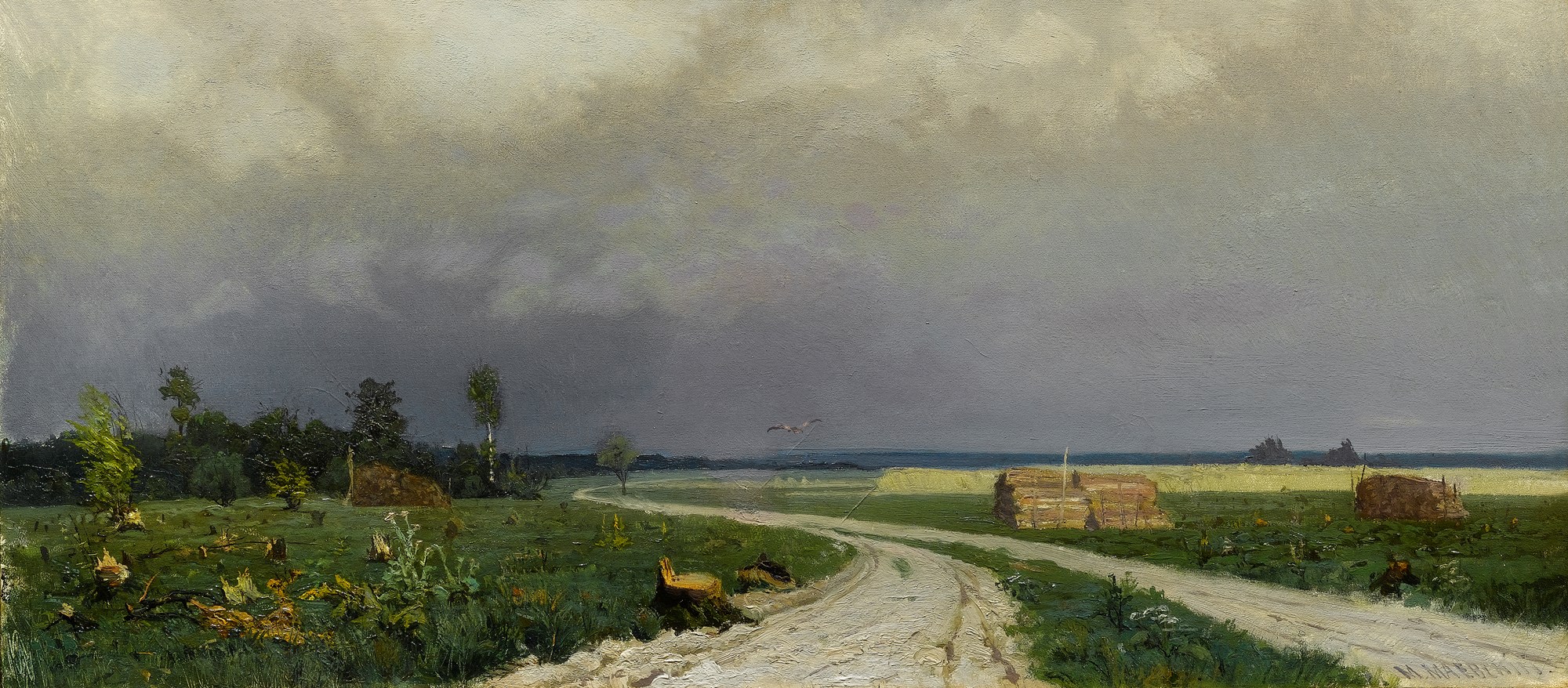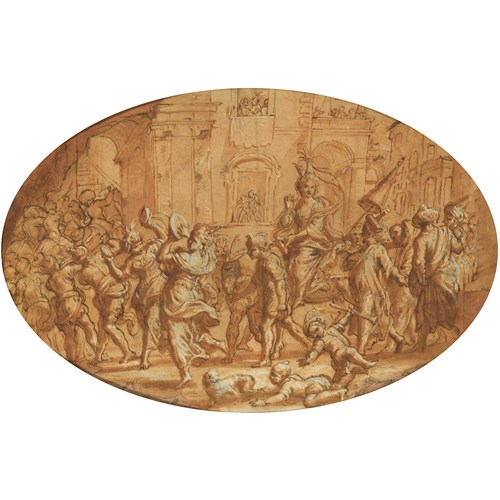Marketplace
The Approaching Storm
Mechislav Silvesterovich Maevsky
The Approaching Storm
Epoque 1850-1900, 19th century
Origine Russia
Medium Oil on canvas laid on board
Dimension 30.5 x 64.8 cm (12 x 25¹/₂ inches)
As its title, The Approaching Storm, would suggest, this landscape is full of natural drama: the deep hues of the dramatically overcast sky indicate the approaching storm. The vegetation and the stacks of hay as well as the stormy weather and blue sky imply that this is probably a mid to late summer’s day. The landscape is classically composed; the eye of the viewer is led into the work by a sweeping track which veers to the left but then sweeps around to the right, bringing to our attention a stack of hay of deep golden hues, highlighted by the dramatic weather. In the upper left-hand corner of the work we can see that the light of the sun has been obscured by the storm clouds overhead. A lone bird flies away from us, giving another warning of the on-coming tempest, whose presence is emphasised by the low horizon
The vegetation in the left half of the composition is of particular interest as Mechislav Silvesterovich Maevsky has perfectly captured the trees being blown about by the wind and its appearance in the overcast light. The vegetation, trees and hay have been rendered using thick, highly visible brushstrokes. Maevsky’s use of colour further draws attention to the debris strewn across the dark grass. These highly expressive and graphic brushstrokes differ from the technique used to represent the large expanse of sky, where the paint is more smoothly blended. These two techniques work well together, showing each part of nature in its own right, whilst also unifying it in order to present the effect of the looming storm. The artist’s interest in the effects of light and atmosphere indicate a probable awareness of modern French painters, including the Impressionists, who were interested in the portrayal of light and atmospheric effects, and whose influence is tangible in Maevsky’s use of paint.
Maevsky was a painter who specialised in landscapes. He studied at the Imperial Academy of Arts and also completed a scientific course in 1878. Maevsky, like many of his nineteenth-century contemporaries, was strongly influenced by a growing nationalist sentiment. They chose to represent the agrarian heart of the countryside, almost in iconic terms, in the landscapes they produced; as Henk van Os explains: ‘Russian artists sought to portray the soul of Mother Russia… Russian landscape artists wanted to penetrate imaginatively into the very essence of their countryside.’¹
There are clearly connections between the work of Maevsky and the celebrated landscape artist Isaac Ilich Levitan (1860-1900). Levitan advanced the genre of the 'mood landscape' and chose a muted palette to reflect the naturalistic and poetic subtleties of nature. In Levitan’s work, see figure 1, the influence of Jean-Baptiste-Camille Corot (1796-1875) and Claude Monet (1840-1926) is discernible. Both Maevsky and Levitan applied paint with a broad brushstroke and in large bands of colour. In The Approaching Storm and The Vladimirka Road, the composition is framed by a centrally positioned, and seemingly infinite, path that leads the viewer's eye throughout the surrounding countryside. A monumental sense of space is also created in both paintings as the sprawling fields and vegetation seem to reach far beyond the limits of the canvas.
¹ Russian landscapes: a première; Groninger Museum/London: National Gallery, 2004, 16-17
The vegetation in the left half of the composition is of particular interest as Mechislav Silvesterovich Maevsky has perfectly captured the trees being blown about by the wind and its appearance in the overcast light. The vegetation, trees and hay have been rendered using thick, highly visible brushstrokes. Maevsky’s use of colour further draws attention to the debris strewn across the dark grass. These highly expressive and graphic brushstrokes differ from the technique used to represent the large expanse of sky, where the paint is more smoothly blended. These two techniques work well together, showing each part of nature in its own right, whilst also unifying it in order to present the effect of the looming storm. The artist’s interest in the effects of light and atmosphere indicate a probable awareness of modern French painters, including the Impressionists, who were interested in the portrayal of light and atmospheric effects, and whose influence is tangible in Maevsky’s use of paint.
Maevsky was a painter who specialised in landscapes. He studied at the Imperial Academy of Arts and also completed a scientific course in 1878. Maevsky, like many of his nineteenth-century contemporaries, was strongly influenced by a growing nationalist sentiment. They chose to represent the agrarian heart of the countryside, almost in iconic terms, in the landscapes they produced; as Henk van Os explains: ‘Russian artists sought to portray the soul of Mother Russia… Russian landscape artists wanted to penetrate imaginatively into the very essence of their countryside.’¹
There are clearly connections between the work of Maevsky and the celebrated landscape artist Isaac Ilich Levitan (1860-1900). Levitan advanced the genre of the 'mood landscape' and chose a muted palette to reflect the naturalistic and poetic subtleties of nature. In Levitan’s work, see figure 1, the influence of Jean-Baptiste-Camille Corot (1796-1875) and Claude Monet (1840-1926) is discernible. Both Maevsky and Levitan applied paint with a broad brushstroke and in large bands of colour. In The Approaching Storm and The Vladimirka Road, the composition is framed by a centrally positioned, and seemingly infinite, path that leads the viewer's eye throughout the surrounding countryside. A monumental sense of space is also created in both paintings as the sprawling fields and vegetation seem to reach far beyond the limits of the canvas.
¹ Russian landscapes: a première; Groninger Museum/London: National Gallery, 2004, 16-17
Epoque: 1850-1900, 19th century
Origine: Russia
Medium: Oil on canvas laid on board
Signature: Signed in Cyrillic ‘M.Maevsky’ (lower right)
Dimension: 30.5 x 64.8 cm (12 x 25¹/₂ inches)
Plus d'œuvres d'art de la Galerie









